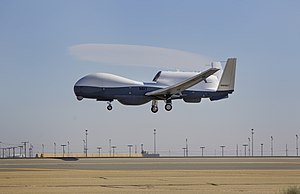MQ-4C Triton
| MQ-4C Triton | |
|---|---|
 |
|
| The prototype MQ-4C, BuNo 168457, on its first flight | |
| Role | Unmanned maritime surveillance and patrol aircraft |
| National origin | United States |
| Manufacturer | Northrop Grumman |
| First flight | 22 May 2013 |
| Status | Testing |
| Primary user | United States Navy |
| Number built | 68 (planned) + 2 prototypes |
| Program cost | US$12,766.5m (as of FY15) |
| Unit cost |
US$120.689m (FY15)
US$182.378m (inc R&D) |
| Developed from | Northrop Grumman RQ-4 Global Hawk |
The Northrop Grumman MQ-4C Triton is an unmanned aerial vehicle (UAV) under development for the United States Navy as a surveillance aircraft. In tandem with its associated ground control station, it is considered an unmanned aircraft system (UAS). Developed under the Broad Area Maritime Surveillance (BAMS) program, the system is intended to provide real-time intelligence, surveillance and reconnaissance missions (ISR) over vast ocean and coastal regions, continuous maritime surveillance, as well as search and rescue missions, for the U.S. Navy, and to complement the Boeing P-8 Poseidon maritime patrol aircraft, but the equipment to link the two platforms is currently unfunded. Triton builds on elements of the Global Hawk while incorporating reinforcements to the air frame and wing, along with de-icing and lightning protection systems. These capabilities allow the aircraft to descend through cloud layers to gain a closer view of ships and other targets at sea when needed. The current sensor suites allow ships to be tracked over time by gathering information on their speed, location, and classification.
The MQ-4C System Development and Demonstration (SDD) aircraft was delivered in 2012 and the MQ-4C was originally expected to be operational by late 2015 with a total of 68 aircraft to be procured. However, in April 2013, the Navy announced that production has shifted from FY14 to FY15 due to additional testing requirements and technical issues related to the aircraft's double-tail vertical stabilizer and rudder, and software integration for maritime sensors. According to the latest information available from the Naval Air Systems Command (NAVAIR), the Initial Operational Capability (IOC) for the MQ-4C is now planned for 2018 with Full Operating Capability (FOC) planned in 2023.
The competitors for the Broad Area Maritime Surveillance (BAMS) contract included:
The BAMS UAS was acquired for the U.S. Navy as a Department of Defense Acquisition Category (ACAT) 1D program and on April 22, 2008, Northrop Grumman received the BAMS contract worth $1.16 billion. Lockheed Martin filed a formal protest with the U.S. Government Accountability Office (GAO) two weeks later. On August 11, 2008 the GAO ruled to uphold the Navy’s selection of Northrop Grumman. In September 2010, the BAMS aircraft was designated the MQ-4C.
...
Wikipedia
